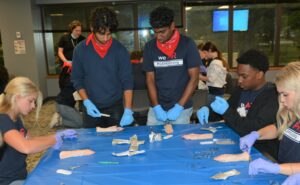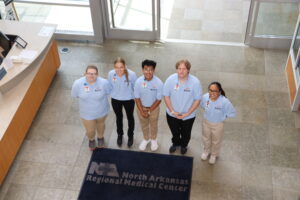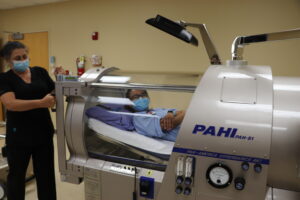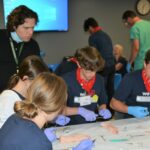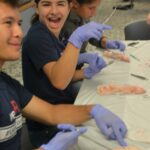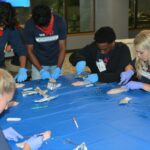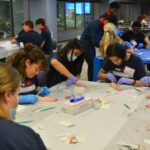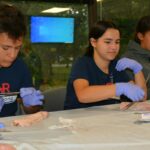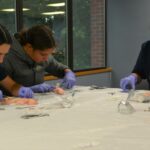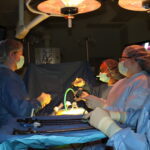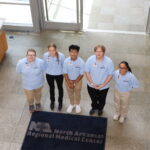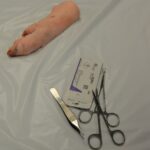UAMS MASH Program Gives High School Students Glimpse Behind the Scenes
| During the summer, high school students can go behind the scenes at the University of Arkansas for Medical Sciences (UAMS) to find out what it really takes to be a health care professional.
Since 1988, hundreds of high school students in Arkansas have donned surgical scrubs or lab coats at UAMS Regional Campuses and community hospitals across the state in order to learn more about health careers. Since that time, UAMS’s Medical Applications of Science for Health (MASH) program has exposed more than 14,000 Arkansas high school students to careers available in the fields of medicine, nursing, pharmacy, dentistry and other health professions. The program is in partnership with Arkansas Farm Bureau.
During this summer’s MASH program at the UAMS Northwest Regional Campus in Fayetteville, some students were squeamish, but most were excited, as they tried their hands at dissecting a pig’s heart under the direction of Rachel Mauldin, M.D., a third-year UAMS family medicine resident, and suturing a pig’s foot under the direction of Wayne Hudec, M.D., a general surgeon at Washington Regional Medical Center. In other sessions, students took detailed notes about college admission processes and scholarships from representatives from the University of Arkansas, John Brown University and Northwest Technical Institute.
During this intensive UAMS summer camp, rising juniors and seniors learn from professionals in a variety of settings about careers in health care. The camps are free and take place in 19 cities around the state. This year, 30 students participated in Fayetteville and interacted with about 35 health care professionals in the region. At North Arkansas Regional Medical Center in Harrison, 16 students went on rounds at the hospital and shadowed or interacted with more than 40 health care professionals.
“Even if a student isn’t sure about what career they want to pursue after high school, this experience can open their eyes to opportunities that they didn’t even know existed,” said Ana Sanchez, recruiting specialist and MASH coordinator for the UAMS Northwest Regional Campus.
That was certainly the case with Nikhil Kamath, who took part in the UAMS Northwest MASH program in 2009 and is now a UAMS anesthesiologist.
“This was my first exposure to the medical field, and it forever had me hooked,” Kamath said. “I had the pleasure of returning as a medical student preceptor for the UAMS Northwest MASH program in 2015. Now I am a physician with UAMS in Little Rock. I have a passion for education and look forward to staying involved with the MASH program.
“MASH will always have an extra-special place in our family because it is where I first met Brooke, who was another participant at the time, and now my wife,” he added. “She is starting her second year in the UAMS Psychiatry Residency Program.”
The MASH program offers a variety of activities and experiences, including:
- CPR Certification
- Dissections
- Suturing
- Nursing
- Pharmacy
- Dentistry and Oral Health
- Sonography
- Mental Health
- Genetic Counseling
- Chiropractor
- Radiology
- Physical Therapy
- Sports Medicine & Orthopedics
Students also hear from local colleges and institutions about the admissions process and scholarship information.
First developed and piloted in 1988 by the UAMS South Central Regional Campus in Pine Bluff, MASH soon spread statewide and has been replicated in several other states. About 600 Arkansas students participate in the program each summer. The program encourages young people to explore the application of scientific theories and concepts to real-life health care fields and scenarios. Students interact with various health care practitioners such as physicians, nurses, physician assistants, medical and radiologic technologists, respiratory therapists, pharmacists, and dietitians. Emphasis is placed on how the different professions function both individually and as part of an overall interdisciplinary team approach to health care.
Exposure to different health professions is an integral part of the MASH experience. Students learn to identify various disciplines, what they do, how they relate to one another, and how the fundamentals of anatomy, biology, pharmacology and physiology apply to each discipline.
The original MASH program was two weeks long. MASH was canceled in 2020 and 2021 because of COVID-19, but the program is back in 2022, although in an abbreviated one-week version.
Interested students must be entering the 11th or 12th grade and have a minimum GPA of 2.5. In a related program, students who will be entering eighth, ninth or 10th grade are eligible for a one-week intensive Community Health Applied in Medical Public Service (CHAMPS) program.
“One of the missions of UAMS is to educate and train the next generation of health care providers,” said Amy Wenger, MHSA, vice chancellor of the UAMS Northwest Regional Campus. “Obviously that includes all of the health sciences colleges that we have on our Fayetteville campus. And by exposing high school students to the many health care profession options that are available to them, we hope to inspire these young, bright minds to pursue a career in health care.”
The CHAMPS and MASH programs have been made possible thanks to support from a partnership between UAMS Regional Programs and Arkansas Farm Bureau. For more information, visit https://regionalcampuses.uams.edu/mash/.
This initiative, under the UAMS leadership of Regional Programs’ Vice Chancellor Richard Turnage, M.D., and Program Director Marcia Byers, PhD, is a collaborative effort between UAMS Regional Campuses and a federal HRSA grant, Arkansas AHEC Point of Service Maintenance/Enhancement Program. This program was supported by the Health Resources and Services Administration (HRSA) of the U.S. Department of Health and Human Services (HHS) as part of an award totaling $12,069,610.00 with 50% financed by UAMS Arkansas AHEC/Regional Campuses sources. The contents are those of the author(s) and do not necessarily represent the official views of, nor an endorsement, by HRSA, HHS or the U.S. Government.


